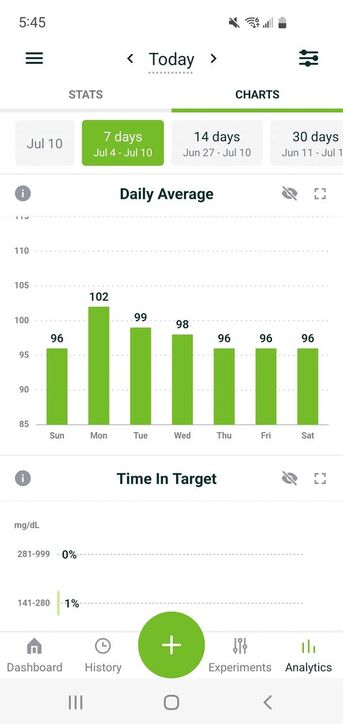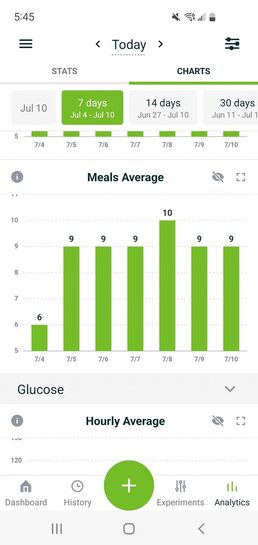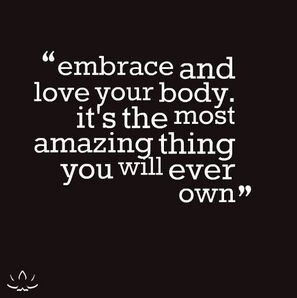
Today concludes my one month exercise using a continuous glucose monitor to track my blood sugar levels. The greatest benefit of the program was the additional insight my dietitian Stephanie added to the process. Whether emails, podcasts, or additional articles, the education she provided was profound. I wouldn't say there were any real downsides to using the CGM except for the guilt that accompanied my indulgent sweet tooth. The CGM is easy to use, water resistant, did not become dislodged with daily activities, and provided consistent trends and feedback. The process increased my empathy toward those with Type 1 diabetes and made me more convinced that prevention of Type 2 rests within our diet and lifestyle. Reducing glucose spikes is one method to reduce overall systemic inflammation and inflammation is frequently identified as a root cause for a variety of diseases. Below, I share with you important recommendations from my NutriSense dietitian to improve insulin sensistivity...and exercise is key!
My question: I think my only remaining question in this month-long exercise is just clarifying the difference between insulin sensitivity versus insulin resistance. We want our bodies to respond to the least amount of insulin necessary to reduce glucose, correct? Or ideally eat in a manner that insulin hardly needs to be released? That would be insulin sensitive? Insulin resistance is when the body has to keep secreting more insulin to combat elevated glucose spikes but with little success? I always appreciate your quick takes on these topics.
My question: I think my only remaining question in this month-long exercise is just clarifying the difference between insulin sensitivity versus insulin resistance. We want our bodies to respond to the least amount of insulin necessary to reduce glucose, correct? Or ideally eat in a manner that insulin hardly needs to be released? That would be insulin sensitive? Insulin resistance is when the body has to keep secreting more insulin to combat elevated glucose spikes but with little success? I always appreciate your quick takes on these topics.

Excellent question regarding insulin sensitivity vs. resistance. So yes, we want our bodies to respond to a meal utilizing the least amount of insulin necessary while keeping glucose well-controlled. This is one of the reasons why exercise is so effective, as the glucose uptake via muscle tissue is non-insulin mediated!
As far as our meal composition, we do want to eat in a way that does not overtax our pancreas. Overtime, this potentially could lead to a progressive loss of beta-cell function (burn out) and decrease in insulin secretion, which results in high blood sugars. The level of carbohydrate tolerance is going to look a little different for everyone based on factors such as level of physical activity, weight, and genetics. The beauty of the CGM is that it allows us to identify our unique threshold.
Insulin resistance occurs at the cellular level. I like to utilize that lock and key analogy to describe this (you are probably familiar). You can think of insulin as your key, it goes to the cell "door" to unlock and allow glucose to enter, where it can then be utilized for energy. When we have insulin resistance, the key is not working well. This again can be due to various causes.
So how do we improve insulin sensitivity? To address the above!
Exercise. The number one way to increase our insulin sensitivity is with exercise.
Diet.
So hopefully that all makes sense. Sometimes my analogies get a little muddy, so let me know if I can clarify anything!
As far as our meal composition, we do want to eat in a way that does not overtax our pancreas. Overtime, this potentially could lead to a progressive loss of beta-cell function (burn out) and decrease in insulin secretion, which results in high blood sugars. The level of carbohydrate tolerance is going to look a little different for everyone based on factors such as level of physical activity, weight, and genetics. The beauty of the CGM is that it allows us to identify our unique threshold.
Insulin resistance occurs at the cellular level. I like to utilize that lock and key analogy to describe this (you are probably familiar). You can think of insulin as your key, it goes to the cell "door" to unlock and allow glucose to enter, where it can then be utilized for energy. When we have insulin resistance, the key is not working well. This again can be due to various causes.
- One reason is excess weight. If we have a layer of fat surrounding our cells, it's going to make it hard for the key to get to the lock. This is why weight loss improves insulin sensitivity.
- Lack of activity can also lead to the key not working well. You can think of glucose as your gas in the tank. If you aren't moving, there's no need for the cells to uptake that glucose for energy use.
- Hormone interference. Hormones like cortisol, catecholamines, progesterone, etc. can negatively impact insulin sensitivity. This is one reason why we are constantly checking in on stress levels and sleep quality!
- Lastly, genetics is a driver. Not a whole lot we can do there other than utilize medications to help our systems out.
So how do we improve insulin sensitivity? To address the above!
Exercise. The number one way to increase our insulin sensitivity is with exercise.
- Include strength training where you are lifting weights. Weight lifting significantly increases insulin sensitivity by increasing non-insulin dependent glucose uptake, which allows your muscles to replenish glycogen without insulin.
- Include exercise that burns through glycogen stores (glucose storage space). This could include HIIT, sprints, intense cycling, swimming, CrossFit-like workouts, or training fasted.
- Move throughout the day and avoid being sedentary. Break up every hour of sitting with 5 minutes of activity, such as a quick set of pushups and lunges. Aim for at least 10,000 steps per day.
Diet.
- Focus on whole foods with minimal processing.
- For most people, a generally low carb diet is best. The more physically active you are, the more carbohydrates you will be able to tolerate.
- Including vinegar, cinnamon, bitter greens and vegetables, fermented foods, green tea, and turmeric can improve insulin sensitivity.
So hopefully that all makes sense. Sometimes my analogies get a little muddy, so let me know if I can clarify anything!

Thanks for following along on this 1-month journey. If you have any questions, please just ask! Take care of yourself today and always.
 RSS Feed
RSS Feed